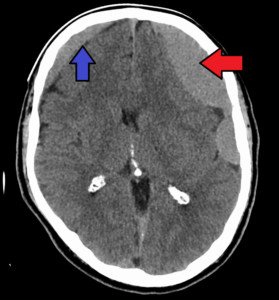
Did you recently get hit in the head and are now panicky that there might be bleeding in your brain?
Knowledge is power! Here’s how to know if you should go to the ER.
I was inspired to write this article, which includes an interview with a medical doctor, after reading what laypeople in threads were posting in an effort to reassure OPs who were panicking over getting hit in the head.
I’m going to explain how to overcome your fear that you might have a brain bleed — and this includes for younger people.
Let’s first look at a few myths that have been perpetuated in laypeople forums.
Myth: If you still feel fine a few days after getting hit in the head, you probably don’t have a brain bleed.
Myth: If you didn’t have a headache or other neurological symptoms in the first 20 minutes after hitting your head, you’ll be fine.
Myth: In order to get a brain bleed the strike to your head must be high impact like falling off a ladder or a car crash.
Some Truths
When my elderly mother passed out one morning while standing at the bathroom sink, she fell — an unbroken fall — slamming her head into the porcelain bathtub.
Fully conscious, she reported no headache or any other symptom.
I didn’t observe any symptoms (slurred speech, confusion, seizures, vomiting).
She crawled into bed and seemed normal, wanting to just go back to sleep (which wasn’t unusual for her).
For the next six weeks she was fine. In fact, six weeks after hitting her head, she participated in a Silver Sneakers class and said it was too easy for her.
Next day all hell broke loose: a searing headache and bilateral leg weakness, with one leg subtlety dragging. A CT scan revealed a brain bleed!

What a brain bleed looks like on an imaging study. Source: James Heilman, MD/CreativeCommons
Some years ago my father fell and slammed his head into a door frame.
Instantly he had neurological symptoms (belligerence, perseveration, amnesia). Plus, he was on a blood thinner.
The memory loss of the preceding two weeks of his life persisted for several hours. Amazingly, he never developed a brain bleed!
Do you see what’s going on here? Symptoms — or lack thereof — at the time of trauma are not predictive of a brain bleed!
The Older a Person, the Less Impact Needed to Cause Bleeding in the Brain
This is why slow bleeding (chronic subdural hematoma) is often found in the elderly who, upon being questioned, recall slightly bumping their head several weeks prior in the car door frame.

“Many elderly people are on blood thinners, so a minor injury can cause bleeding and a mild to moderate head injury can cause subdural hematoma with a bleed under the skull,” says Carolyn Dean, MD, ND – Medical Advisory Board Member, Nutritional Magnesium Association at nutritionalmagnesium.org.
The increased incidence of brain bleeds makes everyone worried about head injury, but they don’t take into consideration the blood thinners that are the cause of brain bleed.
“The skull is incredibly hard and it takes a good amount of trauma to penetrate it and cause brain bleed in the younger person. Of course it can still happen, but it’s more rare.”
The people who are panicking the most in health anxiety forums tend to be middle aged or younger—and it’s true that for younger, bigger and firmer brains, it takes more of an impact to tear a vein and cause a slow bleed.
How Not to Panic Over a Brain Bleed
The first three days are critical. This is the “acute” subdural hematoma period. Get past these three days and you are out of the dense part of the woods.
Don’t continue panicking two or three weeks out because this is the “sub-acute” phase; any brain bleed that becomes symptomatic during this time is not immediately life-threatening.
To put it another way, this would not be a Natasha Richardson situation — remember her?
She was actor Liam Neeson’s wife and had sustained fatal head trauma from skiing — and later that day had lapsed into a coma.
Get past three or four weeks, and you can breathe a heavier sigh of relief as far as immediately life-threatening.
It’s extremely unlikely that in a middle aged or younger adult, getting your head hit by the car door frame, or a table after getting up from the floor, will tear a vein.
But what if you fell to the ground and slammed into the back of your head, like I did one day?
I slipped on ice backwards and never had time to break the fall.
My head snapped back and hit the concrete hard. I sprung to my feet and felt fine, never had any symptoms other than a headache six days later (which was probably from the whiplash to my neck), and numerous more mild headaches that followed.
Once I was past the three week mark, I felt a lot more reassured, but I had also put myself on a 90 day grace period.
A chronic subdural hematoma can take 90 days to start causing symptoms.
Brain Bleed More than Three Weeks After Hitting Your Head
In such a case the bleed will already in progress; it’s just that it took more than three weeks to finally start causing symptoms.
But here’s why you should not panic: This is not a situation where you must rush to the ER in a panic and fear you’ll die.
In fact, when my mother was diagnosed around the dinner hour in the ER, she was scheduled for surgery — for the next morning!
She was under observation and medical staff was not concerned that her brain might suddenly hemorrhage out.
If you’re more than three or four weeks out, and you begin developing symptoms…don’t panic.
Have someone drive you to the ER. Do not even THINK about Natasha Richardson.
Another reason not to panic: The corrective surgery takes 15-20 minutes and is non-invasive. It’s a draining procedure. Sometimes the patient remains awake.
Don’t be afraid to fall asleep at bedtime. A buzzed brain needs sleep to help heal.
It’s a myth that sleep will cause a coma in someone who got hit in the head.

Dr. Dean, in practice for 35+ years and author of “The Magnesium Miracle,” is also a naturopath, nutritionist, herbalist, acupuncturist, lecturer and consultant.
 Lorra Garrick has been covering medical, fitness and cybersecurity topics for many years, having written thousands of articles for print magazines and websites, including as a ghostwriter. She’s also a former ACE-certified personal trainer.
Lorra Garrick has been covering medical, fitness and cybersecurity topics for many years, having written thousands of articles for print magazines and websites, including as a ghostwriter. She’s also a former ACE-certified personal trainer.
.


























